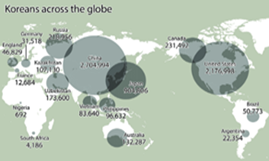Lesson 1: The Korean Diaspora and Korean Americans
Lesson 1: The Korean Diaspora and Korean Americans
Teacher Guide
Teacher Guide

Koreans Across the Globe, 2011
(Source: “World’s widest diaspora born over 100 years ago.” Korea Joongang Daily, October 2, 2013.)
Lesson Features
- TOPICS: Korean Diaspora, Korean Americans, Korean Immigration Patterns and History
- HISTORICAL TIME FRAME: 1880-Present
- SUMMATIVE ASSESSMENT: Oral History Analysis Project
- RESEARCH EXTENSION: Web-Based Research Report
Lesson Overview
- Students are introduced to the Korean diaspora and Korean American immigration patterns and experiences. They complete a short web-based research project on locations of Koreans and Korean Americans. They compare experiences of Korean Americans in the first and second waves of immigrants and consider how these experiences have changed over the 20th century.
Time Frame
- There are two activities in this lesson. Activity 1.1 requires 55 minutes.
- Activity 1.2 includes viewing several videos and could take several days.
- Summative Assessment: Oral history analysis project could be completed for homework or will require an additional day.
- Extension: web-based research report requires 55 minutes and homework.
Objectives and Learning Goals
- Students will be able to define diaspora and identify major countries in the world and states in America where Koreans live today.
- Students will be able to identify examples of the three Korean waves of immigration to the United States.
- Students will be able to identify, compare, and contrast examples of immigrant experiences and issues they faced in the United States.
- Students will be able to identify how Korean immigrant experiences have changed since 1903.
Vocabulary
- Arirang [Arirang]: Korean folk song representing separation and lost love.
- Chinese Exclusion Act of 1882: UNITED STATES law that suspended the immigration of Chinese laborers (skilled or unskilled) from entering into the United States.
- Diaspora: populations, such as members of an ethnic or religious group, that originated from the same place but dispersed to different locations.
- Immigrant wave: the migration of many people simultaneously, so that they appear at once at a given place in great numbers, in comparison with those who go before or come after.
- Quota system: a system, originally determined by legislation in 1921, of limiting the number of immigrants who may enter the United States each year by nationality.
Additional Resources
- Original Lesson: Korean American Experiences and Interethnic Relations
Lesson 1 Presentation (PDF)
Lesson 1 Presentation Teacher’s Guide (PDF)
Download Lesson 1 Presentation (PPT)

